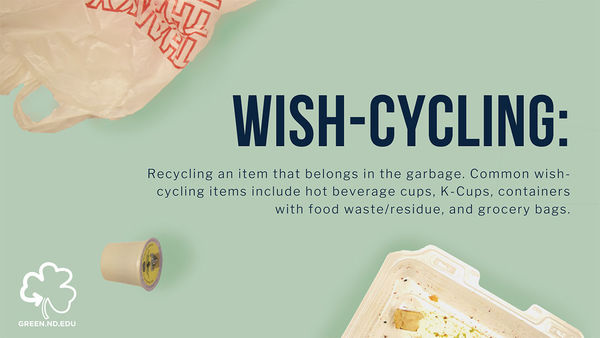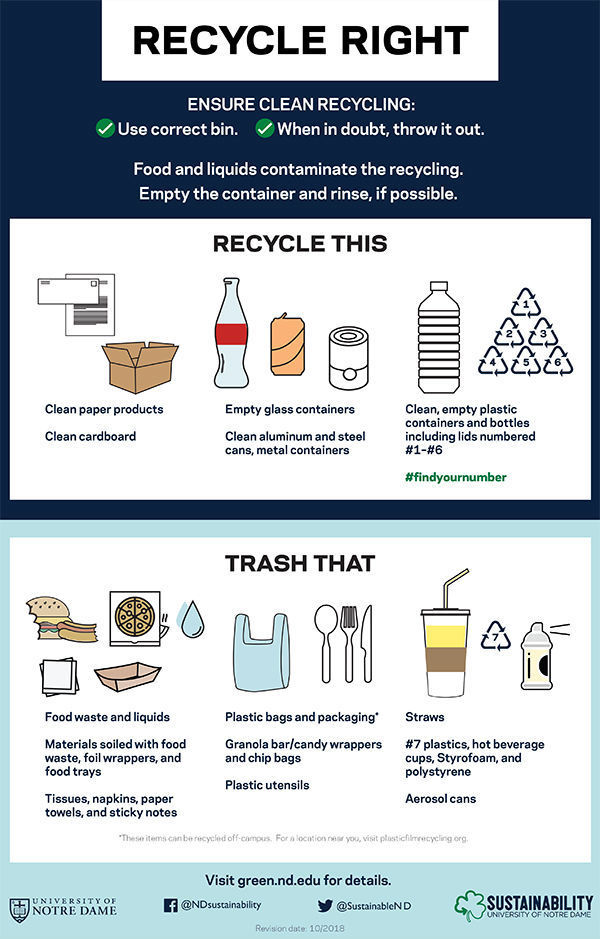
Due to changes in the global market, recycling haulers have implemented stricter requirements for what they will accept as recyclable.
As a result, last fall the University changed campus recycling procedures to ensure the recycling stream is clean and items are actually recovered and recycled. Leaders ask faculty, staff, students and visitors to be vigilant and sort and clean recyclables before throwing them into a recycling bin, and when in doubt to throw them out.
A single contaminated item among a load of otherwise clean recyclables will cause the entire load to end up in a landfill.
Download the recycling poster.
Why so strict?
Much of the recyclable material collected in America is sent overseas. It’s a commodity. But there’s been a shift in the global market, and less of the material is accepted because of the amount of contamination in and on items. (Think of residual cheese or grease inside a pizza box.) The market change has caused waste management and recycling businesses in the U.S. that haul recyclables from homes and businesses to lose money because less of their product is accepted by international companies.
To adapt to the changed market, customers such as Notre Dame must adjust their recycling habits. Other institutions, municipalities and companies across the country face the same pressure as Notre Dame and are moving forward with similar modifications in recycling practices.
 Download the recycling information poster.
Download the recycling information poster.
At Notre Dame, Building Services takes recyclables from bins across campus to giant compactors that compress the items into large masses that the recycling vendor Waste Management hauls to its recycling facility.
What happens to recycling on campus?
If Waste Management identifies contamination in compacted recyclables, the material ends up in a landfill.
For example, that cardboard pizza box with cheese stuck to it would contaminate a much larger unit of compacted recyclables.
Before the new restrictions, any recyclable with 10 percent or less of residue would be accepted and recycled. Now, a load of recyclables may only contain less than 0.5 percent food or beverage residue to avoid
the landfill.
How can the campus community help?
“Wish-cycling” is the well-intentioned behavior of tossing anything into the recycling bin and hoping that it gets sorted out and recycled. What’s missing in that concept is the “someone” who sorts and/or cleans the items.
At Notre Dame, that’s where the campus community can step in. University leaders ask everyone to keep the recycling stream clean and green by thinking of recyclables as a commodity. Items that are not recyclable or cannot be easily rinsed should go into the trash to prevent contamination of the recycling bin.
Plastics 1-6, noted on each plastic container, as well as clean cardboard, newspaper and inserts, magazines, paper, aluminum and glass are all still accepted as recyclables.
The following items are not considered recyclable: paper and foam coffee cups, produce packaging, shopping bags, plastic utensils, coated paper plates, straws, sticky notes, Styrofoam and food foil.
It’s the responsibility of each member of the campus community to keep the recycling stream clean.
A message from the Office of Sustainability
The Office of Sustainability will work with respective building managers or departmental contacts to ensure that offices have solutions that work across campus. The office thanks the campus community for its patience and continued commitment to ensure that the recycling stream is clean. Contact the Office of Sustainability at green@nd.edu or 631-2748 with questions or comments. More information on campus recycling can be found at green.nd.edu. Go to search.earth911.com for information on specialty recycling off campus.
Originally published by at ndworks.nd.edu on November 11, 2019.